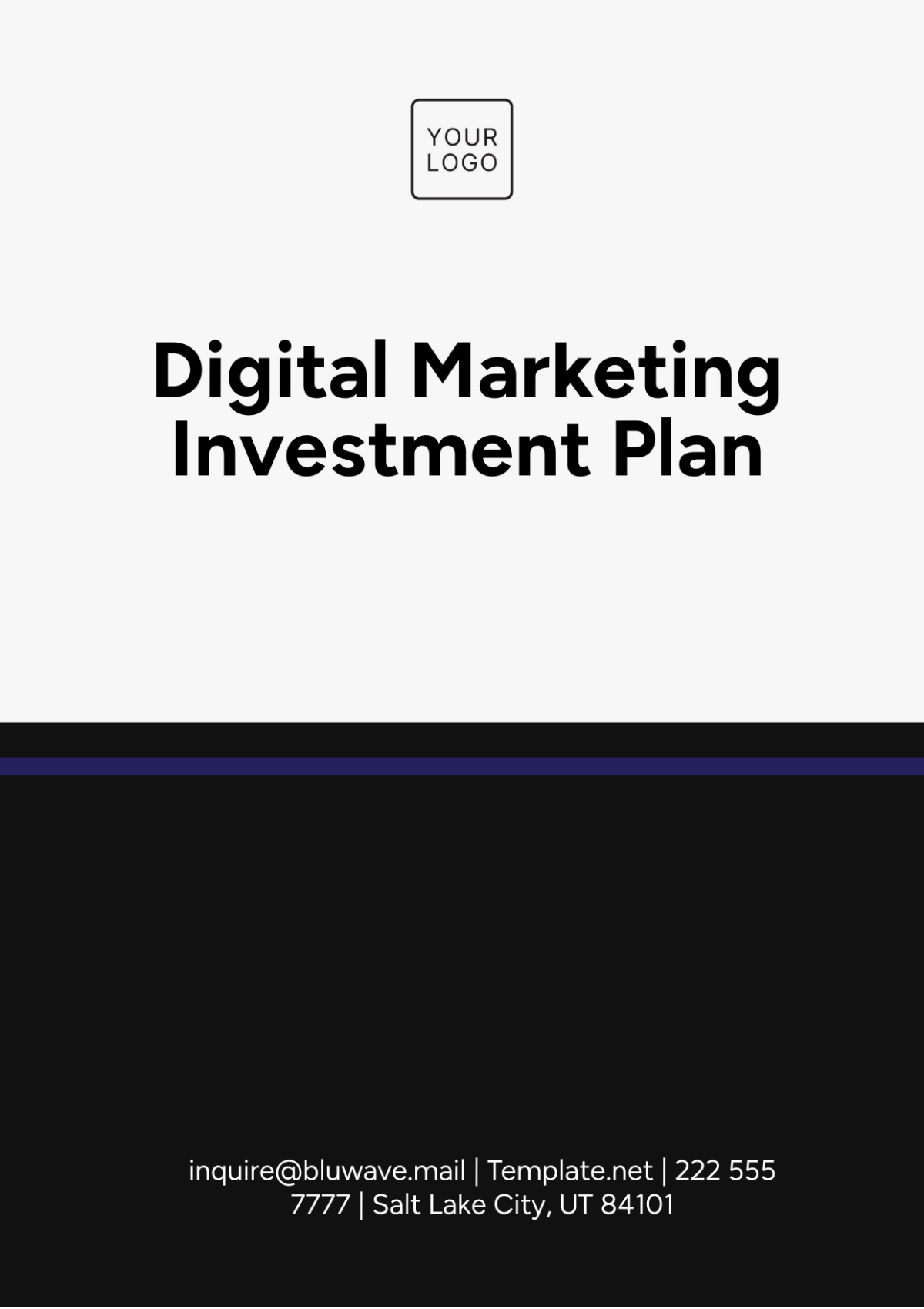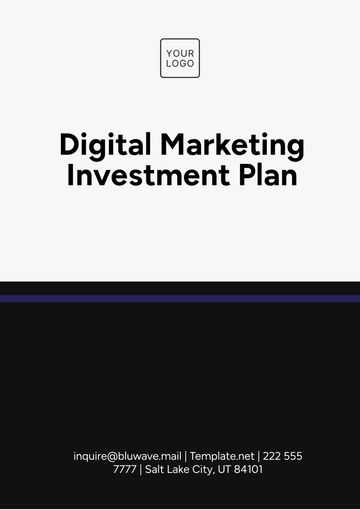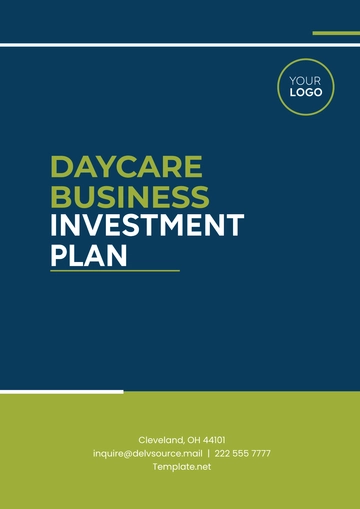Free Digital Marketing Investment Plan

I. Introduction
This Digital Marketing Investment Plan outlines a strategic framework for allocating resources effectively to achieve targeted marketing objectives. The plan encompasses various facets of digital marketing, including budgeting, channel selection, performance measurement, and risk management. It aims to provide a detailed, actionable guide for optimizing digital marketing investments and enhancing overall business performance.
II. Situation Analysis
1. Market Research
Conducting thorough market research is essential for understanding current market trends, customer needs, and the competitive landscape.
Customer Demographics and Behavior
Analyze customer profiles, preferences, and behaviors to tailor marketing efforts.Competitive Analysis
Research competitors' digital marketing strategies to identify gaps and opportunities.Market Opportunities and Threats
Evaluate external factors that can influence the market, such as emerging technologies and economic shifts.
2. SWOT Analysis
Strengths
Strong brand presence
Established customer base
Weaknesses
Limited online engagement
Inconsistent content strategy
Opportunities
Growing demand for digital solutions
Expansion into new markets
Threats
High competition
Rapid technological changes
III. Objectives
Increase website traffic by 30% within six months.
Generate 20% more leads from digital channels.
Enhance brand visibility on social media platforms by 25%.
Achieve a customer retention rate of 15% within the next year.
IV. Budget Allocation
Budget Overview
Effective fund allocation is crucial to maximizing ROI from digital marketing efforts. The proposed budget distribution is as follows:
Channel | Allocated Budget ($) | % of Total Budget |
|---|---|---|
Search Engine Optimization (SEO) | 10,000 | 20% |
Pay-Per-Click (PPC) Advertising | 15,000 | 30% |
Social Media Marketing | 10,000 | 20% |
Content Marketing | 8,000 | 16% |
Email Marketing | 7,000 | 14% |
Total | 70,000 | 100% |
V. Digital Marketing Channels
1. Search Engine Optimization (SEO)
Enhance website visibility through keyword research, on-page optimization, and link-building strategies. Focus on creating high-quality content that answers customer queries and aligns with search intent.
2. Pay-Per-Click (PPC) Advertising
Utilize platforms such as Google Ads and Bing Ads for immediate visibility and targeted outreach. Optimize ad copy and landing pages for higher conversion rates.
3. Social Media Marketing
Engage with the audience on platforms like Facebook, Twitter, and LinkedIn through a mix of paid ads, organic posts, and community interactions. Leverage social listening tools to respond to customer sentiments.
4. Content Marketing
Develop and distribute valuable, relevant content (e.g., blog posts, videos, infographics) aimed at attracting and retaining a clearly defined audience. Implement a content calendar to ensure consistent messaging.
5. Email Marketing
Focus on nurturing leads and retaining customers through personalized campaigns, newsletters, and promotional content. Segment the audience for targeted messaging.
VI. Performance Measurement and Analytics
1. Key Performance Indicators (KPIs)
Website Traffic
Conversion Rate
Customer Acquisition Cost (CAC)
Return on Investment (ROI)
Engagement Rates on Social Media
2. Tools and Platforms
Utilize tools such as Google Analytics, SEMrush, Hootsuite, and Mailchimp to track and analyze performance data. Regular reporting will ensure that strategies are effective and that goals are being met.
3. Reporting and Optimization
Establish a routine for analyzing performance metrics and adjusting strategies accordingly. Monthly reviews will help identify trends, assess campaign effectiveness, and refine tactics.
VII. Risk Management
1. Identifying Risks
Assess potential risks associated with digital marketing efforts, such as budget overruns, compliance issues, and negative public sentiment.
2. Mitigation Strategies
Develop contingency plans for unforeseen circumstances.
Monitor brand reputation and implement proactive measures to address customer feedback.
Regularly review and adjust budget allocations based on performance data.
VIII. Conclusion
Implementing this Digital Marketing Investment Plan will ensure optimized use of resources and improved engagement with the target audience. Continuous monitoring, assessment, and adjustment of strategies will be crucial to maintaining the effectiveness of digital marketing efforts, ultimately driving growth and achieving organizational goals.
- 100% Customizable, free editor
- Access 1 Million+ Templates, photo’s & graphics
- Download or share as a template
- Click and replace photos, graphics, text, backgrounds
- Resize, crop, AI write & more
- Access advanced editor
You may also like
- Finance Plan
- Construction Plan
- Sales Plan
- Development Plan
- Career Plan
- Budget Plan
- HR Plan
- Education Plan
- Transition Plan
- Work Plan
- Training Plan
- Communication Plan
- Operation Plan
- Health And Safety Plan
- Strategy Plan
- Professional Development Plan
- Advertising Plan
- Risk Management Plan
- Restaurant Plan
- School Plan
- Nursing Home Patient Care Plan
- Nursing Care Plan
- Plan Event
- Startup Plan
- Social Media Plan
- Staffing Plan
- Annual Plan
- Content Plan
- Payment Plan
- Implementation Plan
- Hotel Plan
- Workout Plan
- Accounting Plan
- Campaign Plan
- Essay Plan
- 30 60 90 Day Plan
- Research Plan
- Recruitment Plan
- 90 Day Plan
- Quarterly Plan
- Emergency Plan
- 5 Year Plan
- Gym Plan
- Personal Plan
- IT and Software Plan
- Treatment Plan
- Real Estate Plan
- Law Firm Plan
- Healthcare Plan
- Improvement Plan
- Media Plan
- 5 Year Business Plan
- Learning Plan
- Marketing Campaign Plan
- Travel Agency Plan
- Cleaning Services Plan
- Interior Design Plan
- Performance Plan
- PR Plan
- Birth Plan
- Life Plan
- SEO Plan
- Disaster Recovery Plan
- Continuity Plan
- Launch Plan
- Legal Plan
- Behavior Plan
- Performance Improvement Plan
- Salon Plan
- Security Plan
- Security Management Plan
- Employee Development Plan
- Quality Plan
- Service Improvement Plan
- Growth Plan
- Incident Response Plan
- Basketball Plan
- Emergency Action Plan
- Product Launch Plan
- Spa Plan
- Employee Training Plan
- Data Analysis Plan
- Employee Action Plan
- Territory Plan
- Audit Plan
- Classroom Plan
- Activity Plan
- Parenting Plan
- Care Plan
- Project Execution Plan
- Exercise Plan
- Internship Plan
- Software Development Plan
- Continuous Improvement Plan
- Leave Plan
- 90 Day Sales Plan
- Advertising Agency Plan
- Employee Transition Plan
- Smart Action Plan
- Workplace Safety Plan
- Behavior Change Plan
- Contingency Plan
- Continuity of Operations Plan
- Health Plan
- Quality Control Plan
- Self Plan
- Sports Development Plan
- Change Management Plan
- Ecommerce Plan
- Personal Financial Plan
- Process Improvement Plan
- 30-60-90 Day Sales Plan
- Crisis Management Plan
- Engagement Plan
- Execution Plan
- Pandemic Plan
- Quality Assurance Plan
- Service Continuity Plan
- Agile Project Plan
- Fundraising Plan
- Job Transition Plan
- Asset Maintenance Plan
- Maintenance Plan
- Software Test Plan
- Staff Training and Development Plan
- 3 Year Plan
- Brand Activation Plan
- Release Plan
- Resource Plan
- Risk Mitigation Plan
- Teacher Plan
- 30 60 90 Day Plan for New Manager
- Food Safety Plan
- Food Truck Plan
- Hiring Plan
- Quality Management Plan
- Wellness Plan
- Behavior Intervention Plan
- Bonus Plan
- Investment Plan
- Maternity Leave Plan
- Pandemic Response Plan
- Succession Planning
- Coaching Plan
- Configuration Management Plan
- Remote Work Plan
- Self Care Plan
- Teaching Plan
- 100-Day Plan
- HACCP Plan
- Student Plan
- Sustainability Plan
- 30 60 90 Day Plan for Interview
- Access Plan
- Site Specific Safety Plan





























